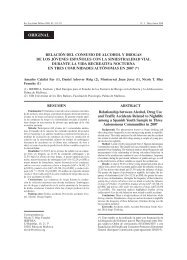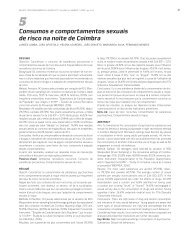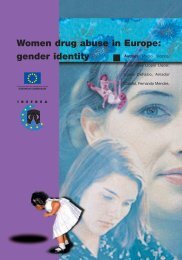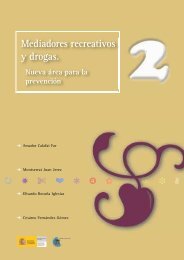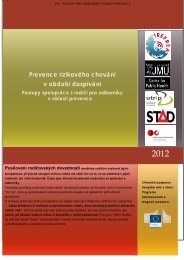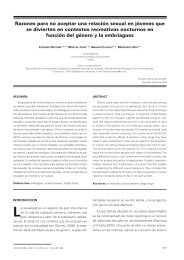Characteristics and social representation of ecstasy in Europe - Irefrea
Characteristics and social representation of ecstasy in Europe - Irefrea
Characteristics and social representation of ecstasy in Europe - Irefrea
You also want an ePaper? Increase the reach of your titles
YUMPU automatically turns print PDFs into web optimized ePapers that Google loves.
UNITED KINGDOMAn article by Pearson (1991) described the notable uncerta<strong>in</strong>ty aroused by thisphenomenon <strong>in</strong> British society, at that time, <strong>and</strong> the feel<strong>in</strong>g that new policies should beadopted. It endeavoured to determ<strong>in</strong>e up to what po<strong>in</strong>t there had been a connectionbetween raves <strong>and</strong> <strong>ecstasy</strong> use. In 1991, it was calculated that 20-30.000 people went toraves every weekend. But how many <strong>of</strong> them used drugs?. The answer was unknown.Some thought that rave parties were overwhelmed with drugs, others that there was noreason for so much alarm.The response <strong>of</strong> the authorities had been to make <strong>ecstasy</strong> illegal but such a measurehad not stopped its be<strong>in</strong>g used. So, what was to be done?. Accord<strong>in</strong>g to Pearson, <strong>in</strong>certa<strong>in</strong> parts <strong>of</strong> the country the general feel<strong>in</strong>g began to be favourable to the idea <strong>of</strong> theorganisers <strong>of</strong> the raves assum<strong>in</strong>g the responsibility <strong>of</strong> provid<strong>in</strong>g <strong>in</strong>formation <strong>and</strong> adviceon drug-related problems.At the present time, the postures <strong>in</strong> respect <strong>of</strong> the adequate preventive measureswhich should be adopted are very divided. Deaths attributable to synthetic drug useraised the voice <strong>of</strong> alarm <strong>and</strong> this provoked a radicalisation <strong>of</strong> a prohibitionist posture,although the other postures also had their supporters. A newspaper article published <strong>in</strong>The Guardian <strong>in</strong> 1996 made the follow<strong>in</strong>g po<strong>in</strong>t, “When Leah Betts died after tak<strong>in</strong>g<strong>ecstasy</strong>, there was widespread panic. Throughout Great Brita<strong>in</strong> worried parents stillbelieve that they can ensure that their children do not come with<strong>in</strong> the reach <strong>of</strong> drugs.They will fail, says Tom Hodgk<strong>in</strong>son, <strong>and</strong> the adolescents will tell them why”(Pool,1996). The same article discussed the effectiveness <strong>of</strong> the anti-drug campaigns,go<strong>in</strong>g on to question whether or not the State has the right to prohibit use. Accord<strong>in</strong>g tothe writer, dem<strong>and</strong> reduction campaigns <strong>of</strong> the “Just Say No” type are campaigns basedon moral pr<strong>in</strong>ciples which, for this reason, do not reach young people, who create theirown moral codes.The same op<strong>in</strong>ion is held by McDermott (1997) <strong>in</strong> “Ecstasy <strong>in</strong> the UK: recreationaldrug use <strong>and</strong> cultural change”. In this article, the writer relates how <strong>and</strong> why a campaignfor <strong>in</strong>formation on harm m<strong>in</strong>imisation was undertaken on the basis <strong>of</strong> the values <strong>of</strong> therave subculture for people who were us<strong>in</strong>g <strong>ecstasy</strong> (the “Chill Out” Campaign), <strong>and</strong> theproblems it encountered from the tabloid press <strong>and</strong> the dom<strong>in</strong>ant ideology who, fromtheir po<strong>in</strong>t <strong>of</strong> view, found it charged with a moral falsehood: “One <strong>of</strong> the pr<strong>in</strong>cipleswhich seems to susta<strong>in</strong> the political <strong>and</strong> newspaper ideology is the notion that it isessentially bad to explore one’s own consciousness us<strong>in</strong>g artificial means. Thisassumption would appear to have its roots <strong>in</strong> Protestantism <strong>and</strong> <strong>in</strong> the modern requisites<strong>of</strong> the discipl<strong>in</strong>e <strong>of</strong> time <strong>and</strong> work which are so necessary for <strong>in</strong>dustrial capitalism”.At the same time, the writer considers that <strong>in</strong>clud<strong>in</strong>g <strong>ecstasy</strong> <strong>and</strong> other danceenvironment drugs <strong>in</strong> the same list <strong>of</strong> drugs as hero<strong>in</strong> <strong>and</strong> coca<strong>in</strong>e may produce anopposite effect to the one desired: “Our research <strong>in</strong>to this group has shown us that as aresult <strong>of</strong> the positive aspects <strong>of</strong> the <strong>in</strong>itial experience with drugs, the MDMA may actas an <strong>in</strong>itiation drug <strong>in</strong>to the use <strong>of</strong> illegal drugs, <strong>and</strong> the lack <strong>of</strong> precise <strong>and</strong> open<strong>in</strong>formation on this drug may lead people to reject messages on all illegal drugs <strong>and</strong> to193



